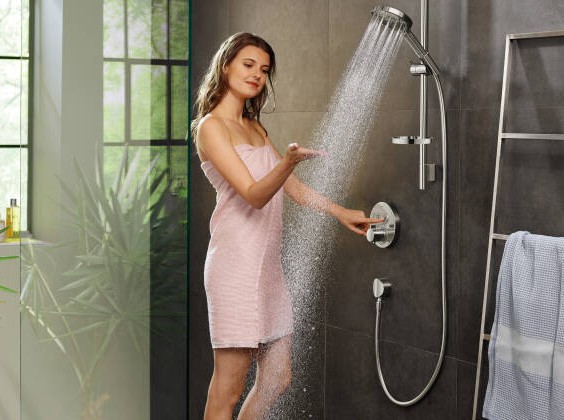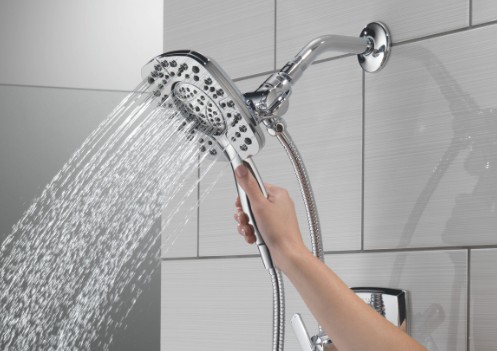A well-functioning shower faucet makes work efficient and conserves water, and you likely won’t give much thought to it unless something goes wrong. Among the common problems that you may encounter is finding out that your shower faucet won’t turn off all the way, but why’s that?
Your shower faucet won’t turn off all the way because of a damaged cartridge, loose or damaged valve stem, and sediment buildup. Other contributing factors include improper installation, water pressure issues, and a faulty O-ring or washer.
Knowing what’s causing the problem isn’t enough; you must fix it too. So, let’s explore the causes further and discuss the solutions as well.

Shower Faucet Won’t Turn Off All The Way (Causes & Fixes!)
| Problem | Causes | Recommended Fixes | |
| 1. | Worn-out or Damaged Cartridge | Corrosion Wear and tear | Replace the old cartridge with a new one |
| 2. | Loose or Damaged Valve Stem | Cracks, breaks, or excessive wear | Tighten or replace the valve stem |
| 3. | Sediment Buildup | Mineral deposits and debris accumulation | Clean the faucet components Clear out the supply lines |
| 4. | Faulty O-ring or Washer | Wear and tear | Fit in a replacement O-ring or washer |
| 5. | Water Pressure Issues | Install or adjust the pressure regulator Tighten connections or replace faulty parts that are causing leaks Clear obstructions | |
| 6. | Improper Installation | Misalignment of components Loose connections Faulty assembly | Reinstall the faucet or repair any misalignments, loose connections, or faulty assembly |
1. Worn-out or Damaged Cartridge
A worn-out or damaged cartridge is a common reason why a shower faucet like Moen shower faucet won’t turn off all the way.
Over time, the cartridge can become worn, corroded, or damaged, resulting in difficulties in fully closing the faucet. A worn-out cartridge may not align properly or have internal parts preventing it from fully closing.
As a result, water can continue to flow even when the handle is turned to the off position. Replacing the cartridge is typically the most effective solution in such cases.
Fix
- Locate the main water valve for your home or the bathroom shut-off valve and shut it off to prevent water from flowing to the shower.
- Take out the faucet handle. You may need to unscrew a decorative cap or cover to access the handle’s mounting screws. Once you remove the screws, carefully lift off the handle.
- Locate the cartridge, which is typically located beneath the handle. It may be secured with a retaining nut or clip.
- Loosen and remove the retaining nut or clip with a wrench or pliers. Then, separate the cartridge from the body of the faucet.
- Install the new cartridge by inserting it into the body of the faucet, ensuring it fits well. Secure it with the retaining nut or clip.
- Reassemble the faucet. Put the handle back in place, then secure it using mounting screws. If applicable, replace the decorative cap or cover.
- Gradually open the main water valve to restore water flow to the shower.
2. Loose or Damaged Valve Stem
A loose or damaged valve stem might be the reason your shower faucet will not turn off all the way. The valve stem connects the faucet handle to the cartridge or valve mechanism and controls the water flow.
When the valve stem becomes loose or damaged, it can prevent the faucet from fully closing.
Fix
- Examine the valve stem for damage signs like excessive wear, breaks, and cracks. Replace a damaged stem. However, if it’s loose, tighten it to see if that resolves the issue.
- Using an adjustable wrench or pliers, gently tighten the valve stem by turning it clockwise. Overtightening can cause further damage, so be careful. Test the faucet once you have tightened the stem to see if it turns off completely.
- If tightening the valve stem doesn’t solve the problem, or it’s damaged, replace it. You’ll need to disconnect the stem from the cartridge or valve mechanism and install a new one. It’s advisable to consult a professional plumber for this task, as it requires specific knowledge and tools.
- Reassemble the faucet and restore water flow.
3. Sediment Buildup
Sediment buildup inside a shower faucet can also cause difficulty in turning off the water completely. Over time, debris and mineral deposits accumulation within your faucet can occur, obstructing the flow and affecting the faucet’s ability to shut off properly.
Fix
Clean the faucet components after stopping the water flow and disassembling the faucet. Do so by inspecting the various parts of the tap, such as the cartridge, valve stem, and aerator, for any visible sediment buildup.
After that, gently scrub away the sediment using a toothbrush you no longer use or a tiny brush. If the residue is stubborn and doesn’t quickly come off, soak the components in a vinegar solution to help dissolve the deposits. Make sure to follow the manufacturer’s guidelines or consult a professional if unsure.
In addition, temporarily remove the showerhead and flush the lines by turning on the water supply for a short time to dislodge and flush out any remaining sediment in the system. This is because deposits can accumulate in the supply lines leading to the faucet.

4. Faulty O-ring or Washer
The O-ring or washer is a small rubber component that creates a watertight seal between different parts of the faucet. If worn, damaged, or dislodged, it can result in leaks and have the faucet fail to shut fully shutting off.
A worn-out O-ring can also explain why your faucet is turned off, but water is still running.
Fix
- You must stop the water flow and disassemble the faucet. Once you successfully do so, inspect the O-ring or washer, but you must locate it first (it is typically found on the valve stem or inside the faucet body).
- Examine the O-ring or washer for signs of wear, damage, or displacement. If it appears worn, damaged, or not seated correctly, replace it.
- Remove the old O-ring or washer, then replace it with a new, functioning one of similar size and type. It’s best to bring the old one with you to a hardware store, especially when unsure, to ensure you buy an exact match. Lubricating the new O-ring or washer with silicone grease before installation helps create a better seal.
- After installing replacement O-rings or washers, reassemble the faucet, then restore the water back to your shower.
5. Water Pressure Issues
High water pressure can put excessive strain on the faucet, causing it to remain partially open. Also, excessively low water pressure causes issues with turning off the shower faucet entirely due to the reduced force of the water flow.
For instance, when the water pressure is too low, there may not be enough pressure to close the valve mechanism inside the faucet properly, leading to incomplete shut-off.
Additionally, weak pressure can cause backflow or the pressure-balancing valve to malfunction.
Fix
a) Check The Water Pressure
Determine if your home has high water pressure by measuring the water pressure using a pressure gauge that attaches to a faucet or consulting a professional plumber. High water pressure is typically defined as anything above 80 psi (pounds per square inch).
b) Install A Pressure Regulator
Installing a pressure regulator can help regulate and reduce the pressure to a safe level if it is excessively high. You will typically install or find a pressure regulator where the primary water line goes into your home.
It requires professional installation, so contacting a plumber is recommended.
c) Adjust The Pressure Regulator
Adjust the regulator to an appropriate pressure level if you have already installed a pressure regulator.
d) Clear Obstructions
Check for any water supply lines or showerhead obstructions that could affect the water flow. Sediment, debris, or mineral deposits can accumulate and restrict the flow, leading to water pressure issues.
Clean or replace the showerhead if necessary.
e) Check For Leaks
Inspect the entire plumbing system for any leaks, including the shower faucet, supply lines, and connections. Even small leaks can reduce water pressure, so fix any leaks by tightening connections or replacing faulty parts.
6. Improper Installation
Improper shower faucet installation can also cause problems stopping water flow completely. An incorrectly installed faucet can result in misalignments or faulty connections that prevent the faucet from shutting off properly.
Here’s how improper installation can cause problems:
i) Misalignment Of Components
If the various components of the faucet (such as the cartridge, valve stem, or handle) are not aligned properly during installation, it can interfere with the closing mechanism.
Misalignment can prevent the components from fitting together snugly, leading to gaps that allow water to continue flowing even when the faucet handle is turned off.
ii) Loose Connections
Failure to securely tighten the connections between different parts of the faucet can cause leaks or prevent the faucet from fully closing. Improper shower faucet installation can also cause problems stopping water flow completely.
Loose connections can make water seep through, preventing the faucet from shutting off completely.
iii) Faulty Assembly
You will also encounter issues turning off the shower faucet if the faucet components are assembled improperly or if essential parts are missing. It can affect the functionality of the faucet and prevent it from closing fully.
Fix
Assess the installation and identify any errors or misalignments. Depending on the issue, reinstall the faucet or perform specific repairs to correct any misalignments, loose connections, or faulty assembly.

How Long Does A Bathroom Faucet Last?
The lifespan of a bathroom faucet can be long or short depending on many factors, including the faucet’s quality, how often you use it, water quality, and maintenance.
However, a well-maintained bathroom faucet can last 10 to 20 years or much longer.
Consider replacing your bathroom faucet if it’s consistently leaking, visibly damaged or corroded, or has outdated features or design. Also, reduced functionality and frequent plumbing issues can indicate the need for a new faucet.
Summary of Shower Faucet Won’t Turn Off All The Way
Troubleshoot your shower faucet if it will not turn off all the way by exploring the causes discussed above. Uncovering the problem will guide you when addressing this issue.
Alternatively, hire a professional plumber or a qualified technician who would identify the specific cause and provide the necessary repairs or replacements to resolve the problem effectively.
